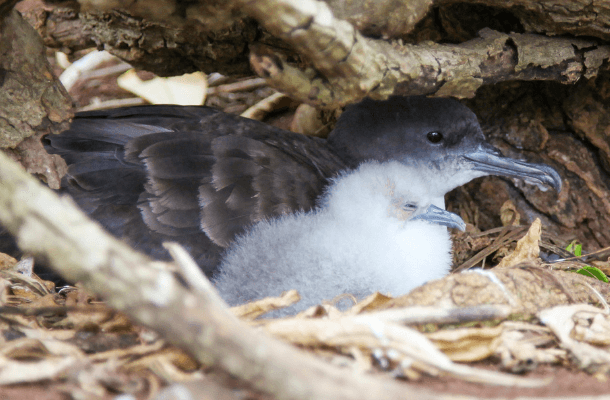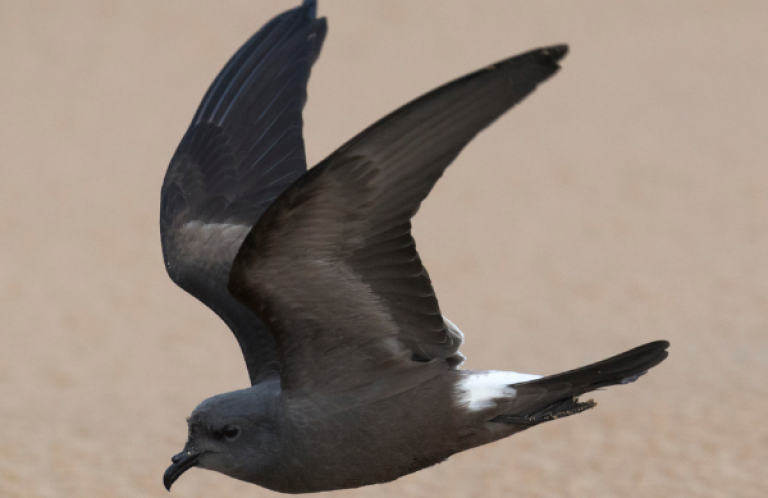Seabirds' Return a Key Step in Restoring Moloka'i Coastal Ecosystem

Wedge-tailed Shearwaters have returned for the first time in recent history to a restored coastal habitat on Moloka'i. Photo by Digital Studio J/Shutterstock
A bold effort by the Moloka'i Land Trust and American Bird Conservancy (ABC) to restore 90 acres of remote coastal habitat on Moloka'i's north shore took an important step forward in August 2020, when Wedge-tailed Shearwaters were documented breeding at the site for the first time in recent history. Signs of shearwater burrow excavation were noted in three different areas and included five active nests. Two chicks were found in nests. Fossil bird bones have also been found at this site, indicating shearwaters historically nested at Mokio.
“Restoring seabirds into the Mokio coastal ecosystem has always been a goal of the Mokio restoration partnership,” says Brad Keitt, Director of ABC's Oceans and Islands division. “We currently have decoys and a sound system to attract Laysan Albatross to the site. Burrowing seabirds like the Wedge-tailed Shearwaters are another critical part of restoring the site, and we are excited to see them return. Once the predator-proof fence is complete, it will be safe for burrowing seabirds to return in force. Eventually, this site may attract some of the endangered seabirds found only in Hawai'i such as the Hawaiian Petrel and Newell's Shearwater.”
For the past four years, ABC has been working with the Moloka'i Land Trust, the U.S. Fish and Wildlife Service (USFWS) Coastal Program, and other partners to study seabirds at the site and design a plan for the construction of a predator-proof fence at Mokio Preserve that will allow seabirds such as the Laysan Albatross, Wedge-tailed Shearwater, and other species to colonize the site. A temporary fence to keep out deer has enabled native plant restoration to take root over the majority of the site. A key part of this work: getting research scientists, such as those at Maui Nui Seabird Recovery Project and the U.S. Geological Survey (USGS), to consult on methods to establish baseline data and monitor restoration results. Acoustic monitoring systems, called song meters, were set up in 2016 to determine if nocturnal seabirds were present.
“There had been a few detections of Wedge-tailed Shearwaters on song meters, suggesting they were in the area, but no successful nesting until now. This is a direct benefit of protecting the site,” says Hannah Nevins, ABC's Seabird Program Director. “This is great news and lends more urgency to getting the fence built as soon as possible.”
Coastal habitats in Hawai'i and around the world are also threatened by sea level rise, development, and overuse. Restoring coastal ecosystems provides resiliency that can help buffer sea level rise and maintain or improve the health of corals and fish populations, as well as habitat for endangered species. Increasingly, conservation fences designed to keep out invasive predators are being used to speed up coastal ecosystem recovery. While the fences keep out animals as small as invasive mice, gates allow human access for study, and, where permitted, recreation such as fishing and sightseeing.
“Mokio is a special place and it has been phenomenal to see the transformation from a degraded area, dominated by nonnative kiawe (a tropical mesquite tree) to primarily native coastal strand habitat with blooming native species carpeting the ground,” says Butch Haase, Executive Director of Moloka'i Land Trust, who has been leading the effort to protect this site since 2010. “It is possible now to stand in the middle of the preserve and see only native species and ocean, giving people a chance to experience what Hawai'i used to be like. It is our hope that seeing this restored land will inspire others to do the same elsewhere across our islands.”
Seabirds are a critical part of coastal ecosystems. As top-level marine predators, they bring nutrients from the ocean to their nests. In turn, their droppings fertilize coastal plants and nearshore waters. Recent research has shown that islands with healthy seabird populations have healthier corals and fish populations near them. A recently published study also calculated that nutrients deposited via seabird feces constitute an ecosystem service valued at $473 million annually, and over $1 billion when secondary benefits (valued at $650 million) are added.
Invasive predators such as rats, mongooses, and cats are the leading cause of seabird declines. Excluding these animals with specially designed fences is a proven tool to restore seabird colonies.
The Mokio-Anapuka Restoration Site is the result of a partnership between ABC, Moloka'i Land Trust, Maui Nui Endangered Seabird Recovery Project, USFWS, USGS, and the Hawai'i State Department of Land and Natural Resources, Maui-Nui Native Ecosystem Protection and Management team.
ABC is grateful to the following supporters for making this project possible: United States Fish and Wildlife Service Coastal Program, Science Applications Program, and the Partners Program; the David and Lucile Packard Foundation; Lynn and Stuart White; the BAND Foundation; and the Sacharuna Foundation.
###
Media Contact: Jordan Rutter, Director of Public Relations, 202-888-7472 | jerutter@abcbirds.org | @JERutter
Expert Contact: Hannah Nevins, Seabird Program Director, 808-333-4469 | hnevins@abcbirds.org
Project Contact: Butch Haase, Moloka'i Land Trust Executive Director, 808-366-6675 | butch@molokailandtrust.org
American Bird Conservancy is a nonprofit organization dedicated to conserving birds and their habitats throughout the Americas. With an emphasis on achieving results and working in partnership, we take on the greatest problems facing birds today, innovating and building on rapid advancements in science to halt extinctions, protect habitats, eliminate threats, and build capacity for bird conservation. Find us on abcbirds.org, Facebook, Instagram, and Twitter (@abcbirds).
Moloka'i Land Trust is a nonprofit Hawaiian-based organization which has a mission to protect and restore the land, natural and cultural resources of Moloka'i, and to promote, educate and perpetuate the unique Native Hawaiian traditions and character of the islands for the benefit of the future generations of all Moloka'i, particularly Native Hawaiians. Find MLT on molokailandtrust.org, Facebook, and Instagram.


















































